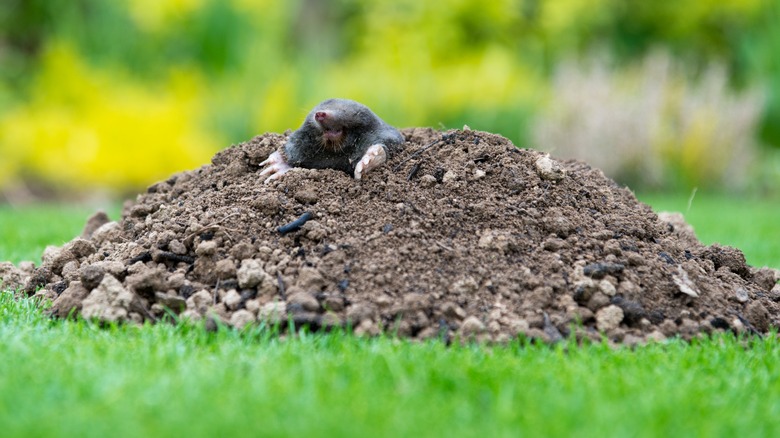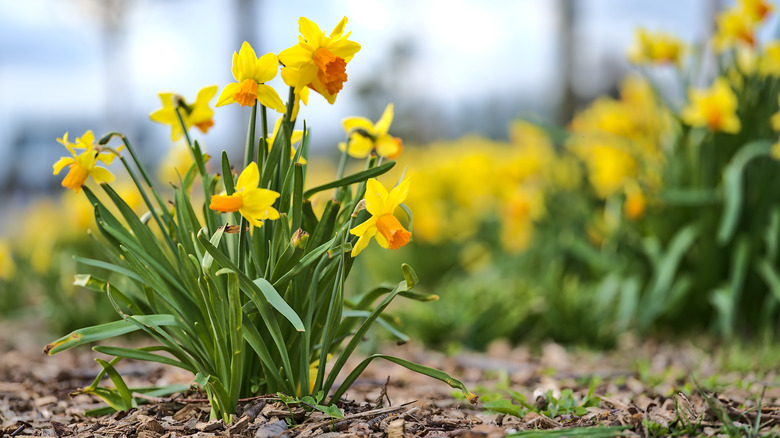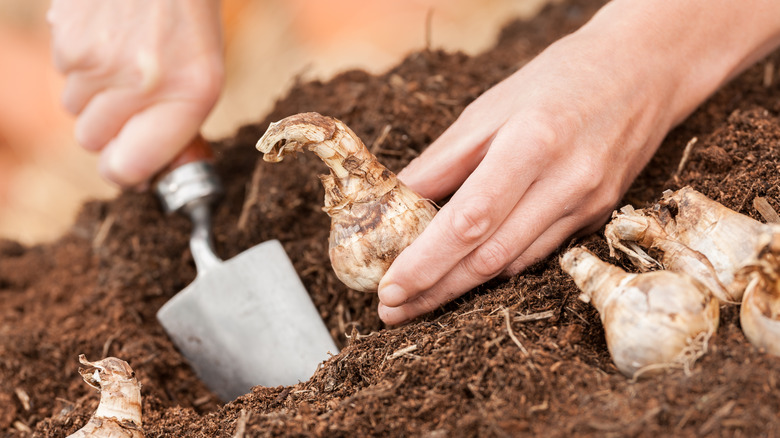This Beautiful Spring Flower Will Keep Moles From Damaging Your Yard Naturally
If you've spotted lines of raised soil winding through your lawn or garden, you may have an unwelcome visitor: the hairy, hardworking mole. Moles are small mammals that spend most of their lives underground, using their giant digging claws to build a network of tunnels through the soil. They can become the bane of a gardener's existence when their underground efforts to find insects to eat damage roots, bury seedlings, or push plants out of the ground. Mole tunnels can help aerate soil, but can also pave the way for other critters to infiltrate your yard. So, for many gardeners, the downsides of a mole occupation clearly outweigh the upsides. Fortunately, there's a simple, humane way to keep moles out in the first place: planting daffodils.
Daffodils (Narcissus pseudonarcissus) are hardy perennial plants that are easy to maintain in USDA zones 3 through 8. There's evidence of gardeners planting daffodils going all the way back to the 1600s, so they've been popular for a long time. Their cheery blooms, which range in color from white and yellow to shades of orange and pink, are the perfect antidote to a long, dark winter, as they bloom in the spring. Daffodils tend to foster nutritional conditions in their surrounding soil, making them handy to have nearby for any neighboring plants. And they can easily be used to create a harmless, effective, and beautiful line of defense against numerous garden-wrecking creatures ... especially moles.
Why daffodils deter moles
There are many approaches to mole control, though not all of them are effective or humane. You can use traps to get rid of moles, but this isn't a long-term solution. Even if you exterminate or relocate them, more will eventually dig their way in. Instead, planting daffodils in your yard may be more effective, as daffodil plants and their relatives (flowers in the Amaryllidaceae family) give off a fragrance that's believed to be unpleasant to moles' strong sense of smell. The plants also contain lycorine, a poisonous chemical that could also help deter the pests, as they may be able to detect that it's harmful. However, daffodils will never harm moles, as these animals don't eat plants. Instead, the flowers will simply force them to dig their tunnels elsewhere.
The best way to use daffodils against moles is to plant them along the perimeter of your yard or garden. If a mole tunnels into a line of daffodils, it will think twice about continuing in that direction. However, if you already have moles excavating your outdoor space, planting daffodils may not be enough to drive them out (unless you want an entire garden of daffodils). Instead, start by trapping and relocating the existing moles, then plant daffodils around the border to prevent them from returning. You can also add marigolds, another low-maintenance flower that'll keep moles out of your yard. In fact, there are numerous flowers and herbs that moles can't stand, so if you don't happen to be a daffodil fan for whatever reason, there are plenty of other plants with a similar impact on moles. However, if you find that your pest problem persists, you may need to call an exterminator.
How to plant and maintain daffodils
When planting daffodil bulbs in the fall, timing is critical. The soil needs to be cold enough to signal the bulbs to grow roots, but the bulbs need enough time to develop a strong root system before the soil freezes. Wait until the soil is 55 degrees Fahrenheit or lower — usually in October or early November. To plant daffodil bulbs, dig holes deep enough that the distance from the top of the bulb to the top of the soil is roughly double the length of the bulb. Experts recommend spacing the bulbs 4 to 6 inches apart. You can plant them closer together to create a more dramatic grouping of flowers, but they will eventually get overcrowded.
Place a bulb in each hole, cover with soil, and water once right after planting. After that, all you have to do is wait. The bulbs will work their magic underground over the next several months and start sprouting when the weather turns warm. Take care of your daffodils with regular, moderate watering. After the flowers die, avoid cutting back the leaves, which are still using photosynthesis to deliver energy to the bulb. This will allow your daffodils to keep popping up year after year to announce the start of spring — and to protect your yard from moles.


